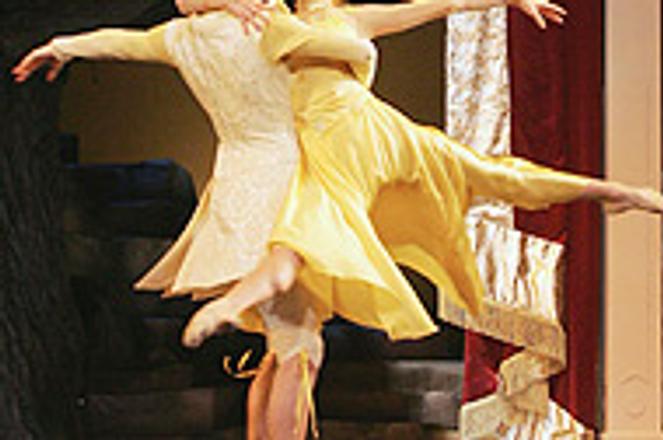A Midsummer Night's Dream
Libretto:Etienne Frey, based on the play by William Shakespeare
Music:Peter Zagar
Choreography:Etienne Frey
Where:Slovak National Theatre (SND), Hviezdoslavovo nám., Bratislava
Next performance:February 25 at 19:00
Performed:Ballet in four acts
Rating:7 of 10
Roman Novitzky (Lysander) and Katarína Košíková (Hermia).
photo: Courtesy of SND
"BALLET is a young person's game," writes John Rockwell of The New York Times. "If you reach 40 and are still dancing principal roles, you're considered some kind of quirk of nature - or resented by younger dancers for blocking their potential career paths."
The Slovak National Theatre (SND) Ballet apparently agrees. Last weekend's premiere of A Midsummer Night's Dream was chock full of rising talent, from the SND's sprightly dancers to Swiss choreographer Etienne Frey and Slovak composer Peter Zagar.
And that is appropriate for a comedy that, like Romeo and Juliet, focuses on young lovers, albeit with a happier ending.
The ballet begins as Egeus arrives in the court of Theseus, the Duke of Athens, to request that his daughter Hermia be ordered to marry Demetrius. Hermia loves Lysander, though, and refuses, despite the threat of life in a nunnery or death. To escape this fate, Lysander and Hermia sneak off into the woods to marry. Hermia's friend, Helena, learns of their plans and informs Demetrius, who joins her in following them.
Frey's choreography wedded rigorous ballet technique to the youthful sensuality of modern dance. With legs nicely turned out and feet pointed, the dancers eagerly pulled each other close, swung in circles, ducked under and around with silken fluidity, and playfully slid over each other.
Roman Novitzky (Lysander) radiated innate intensity and strength, but needed more balance, especially in pirouettes, and sharper movements. Katarína Košíková (Hermia) displayed genuine chemistry with Novitzky, particularly during their Act I pas de deux. Her facial expressions were effective and highly communicative. Štefan Ďurec (Demetrius) and Klaudia Bittererová (Helena) were also excellent.
This all happened on top of Peter Zagar's confusing score, which offered the audience only two paths: the obvious or the bizarre. Zagar's use of a wide range of instruments from the modern orchestra, though, did give the music a distinctive versatility.
The story continues in the woods as Oberon, King of the Fairies, and Puck, his loyal but mischievous servant, entertain themselves with the young humans' travails. Oberon orders Puck to enchant Demetrius with a magic flower so he'll love Helena instead of Hermia, but Puck enchants Lysander by mistake. Oberon attempts to correct things by enchanting Demetrius as well, but even this results in chaos, as both men end up in love with Helena and begin to fight over her. Oberon finally creates a thick fog to separate everyone and let the spell wear off.
František Šulek (Oberon) showed flexibility, good extension during leaps, and precision. But, as in the original play, Puck was undoubtedly the centre of attention. Juraj Žilinčár (Puck) featured the trademark of a great physical comedian - the ability to go over the top while maintaining complete control. His jumps were high and graceful and each of his scenes was hilarious.
The story ends when Theseus and Egeus find the young lovers in the woods and agree to let them choose who to marry. Everyone returns to Theseus' court for a celebration and the fairies frolic.
Set designer Dušan Soták chose deep colours, especially for the woods, which blended dark green leaves with a rich indigo sky. Costume designer Katarína Holková, herself a young talent, also experimented with the symbolism of colours, using red wigs to indicate passion and white dresses to show purity and innocence.
But the choreography remained uneven. The young soloists' scenes were always very clear, but the corps de ballet's choreography often seemed unconnected to the drama, which slowed the story rather than advancing it or adding dimension.
Nonetheless, it is clear that certain stars in the SND Ballet's own indigo sky will continue to shine brightly in the years to come.

